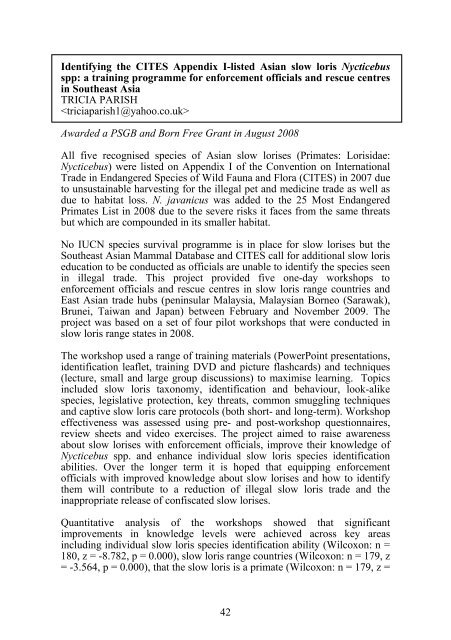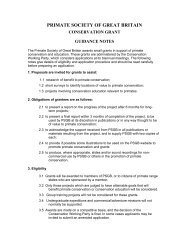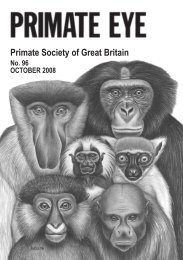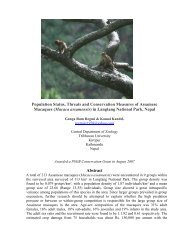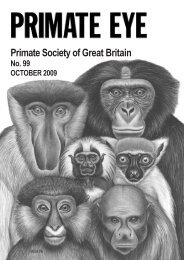2010 Vol 101.pdf (1.63mb) - Primate Society of Great Britain
2010 Vol 101.pdf (1.63mb) - Primate Society of Great Britain
2010 Vol 101.pdf (1.63mb) - Primate Society of Great Britain
Create successful ePaper yourself
Turn your PDF publications into a flip-book with our unique Google optimized e-Paper software.
Identifying the CITES Appendix I-listed Asian slow loris Nycticebus<br />
spp: a training programme for enforcement <strong>of</strong>ficials and rescue centres<br />
in Southeast Asia<br />
TRICIA PARISH<br />
<br />
Awarded a PSGB and Born Free Grant in August 2008<br />
All five recognised species <strong>of</strong> Asian slow lorises (<strong>Primate</strong>s: Lorisidae:<br />
Nycticebus) were listed on Appendix I <strong>of</strong> the Convention on International<br />
Trade in Endangered Species <strong>of</strong> Wild Fauna and Flora (CITES) in 2007 due<br />
to unsustainable harvesting for the illegal pet and medicine trade as well as<br />
due to habitat loss. N. javanicus was added to the 25 Most Endangered<br />
<strong>Primate</strong>s List in 2008 due to the severe risks it faces from the same threats<br />
but which are compounded in its smaller habitat.<br />
No IUCN species survival programme is in place for slow lorises but the<br />
Southeast Asian Mammal Database and CITES call for additional slow loris<br />
education to be conducted as <strong>of</strong>ficials are unable to identify the species seen<br />
in illegal trade. This project provided five one-day workshops to<br />
enforcement <strong>of</strong>ficials and rescue centres in slow loris range countries and<br />
East Asian trade hubs (peninsular Malaysia, Malaysian Borneo (Sarawak),<br />
Brunei, Taiwan and Japan) between February and November 2009. The<br />
project was based on a set <strong>of</strong> four pilot workshops that were conducted in<br />
slow loris range states in 2008.<br />
The workshop used a range <strong>of</strong> training materials (PowerPoint presentations,<br />
identification leaflet, training DVD and picture flashcards) and techniques<br />
(lecture, small and large group discussions) to maximise learning. Topics<br />
included slow loris taxonomy, identification and behaviour, look-alike<br />
species, legislative protection, key threats, common smuggling techniques<br />
and captive slow loris care protocols (both short- and long-term). Workshop<br />
effectiveness was assessed using pre- and post-workshop questionnaires,<br />
review sheets and video exercises. The project aimed to raise awareness<br />
about slow lorises with enforcement <strong>of</strong>ficials, improve their knowledge <strong>of</strong><br />
Nycticebus spp. and enhance individual slow loris species identification<br />
abilities. Over the longer term it is hoped that equipping enforcement<br />
<strong>of</strong>ficials with improved knowledge about slow lorises and how to identify<br />
them will contribute to a reduction <strong>of</strong> illegal slow loris trade and the<br />
inappropriate release <strong>of</strong> confiscated slow lorises.<br />
Quantitative analysis <strong>of</strong> the workshops showed that significant<br />
improvements in knowledge levels were achieved across key areas<br />
including individual slow loris species identification ability (Wilcoxon: n =<br />
180, z = -8.782, p = 0.000), slow loris range countries (Wilcoxon: n = 179, z<br />
= -3.564, p = 0.000), that the slow loris is a primate (Wilcoxon: n = 179, z =<br />
42


